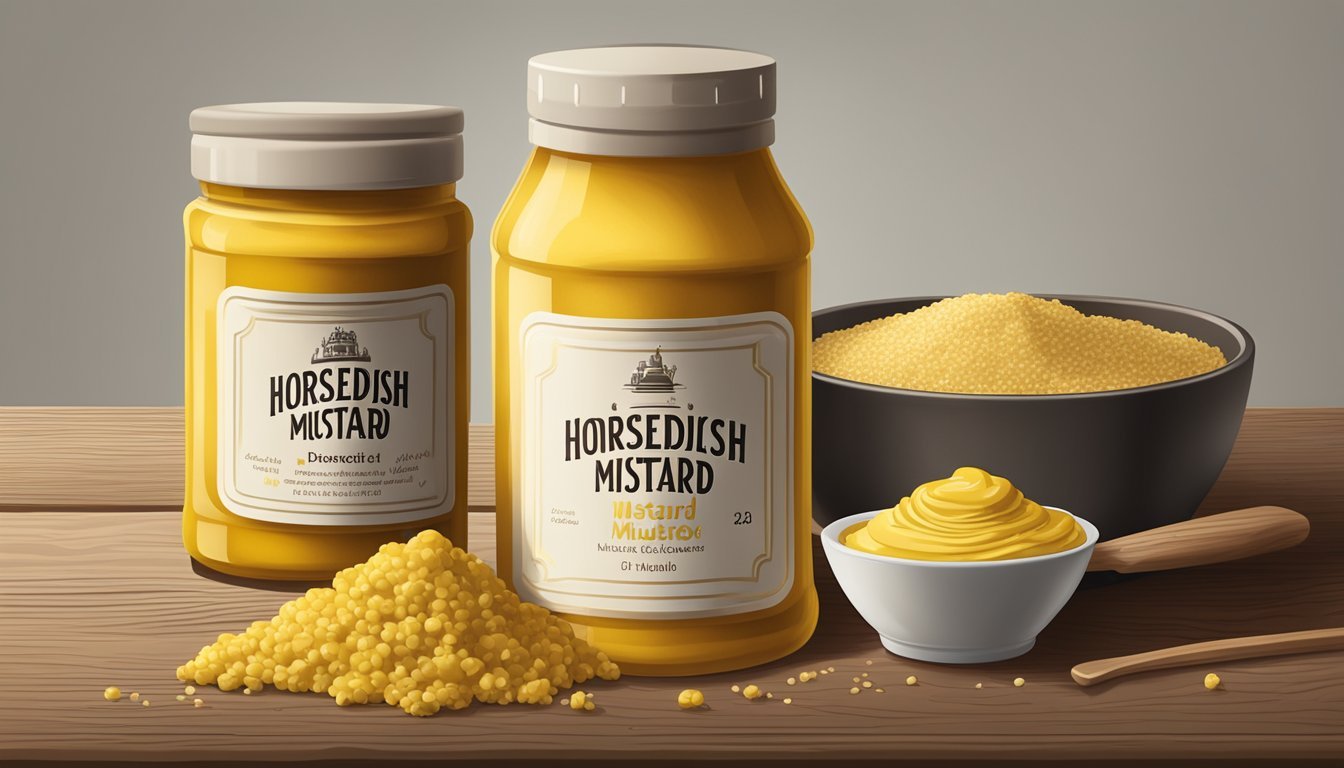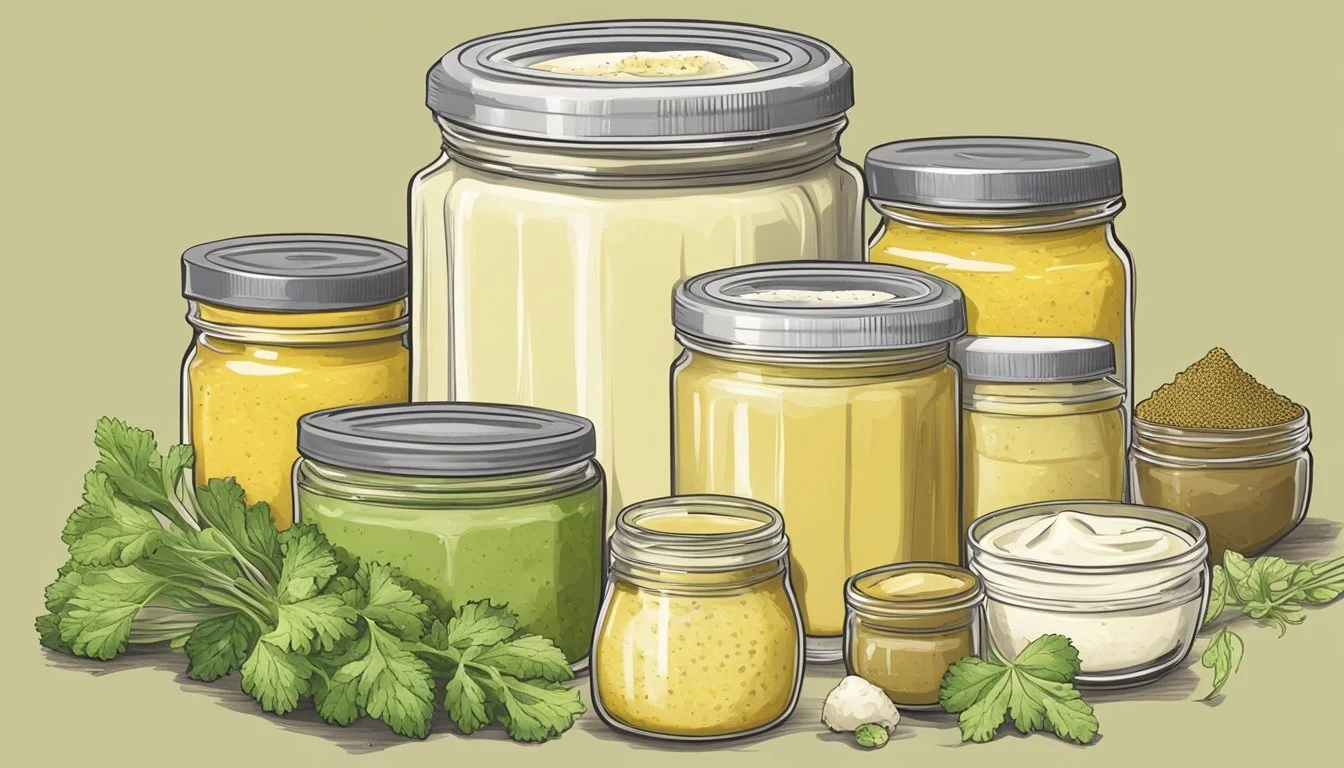Horseradish Mustard Substitutes
Top Alternatives for Your Recipes
Horseradish mustard is a condiment that brings a unique combination of heat and tang to dishes. It’s characterized by the distinctive sharpness of horseradish blended with the depth of mustard, creating a flavor profile that is hard to replicate. However, when horseradish mustard isn’t available or when individual dietary preferences dictate, several alternative ingredients can provide a comparable kick to recipes calling for this piquant spread.
Substitute options range from the sharpness of wasabi, which is often similarly based on horseradish itself, to the complexity of various types of mustard. Wasabi, in particular, shares a close flavor resemblance given its common use of horseradish as a primary component, although it may introduce a slight green hue to dishes. Alternatively, mustards such as spicy brown or Dijon can partially mimic the heat and texture, albeit with a different flavor profile. Ginger, while less similar in taste, can also impart a fiery zing that echoes the punch of horseradish mustard in culinary applications.
Understanding Horseradish Mustard
Horseradish mustard combines the heat of horseradish root with the tangy flavor of mustard seed, offering a pungent and spicy taste that energizes a variety of dishes.
Composition of Horseradish Mustard
Horseradish mustard is crafted from a blend of ground mustard seed and freshly grated or prepared horseradish—a root vegetable known for its fiery taste. Often, vinegar is added to the mix to enhance its flavors and preserve the condiment. In some variations, cream or other binders may be incorporated to create a smoother texture and to temper the spice level.
Primary Ingredients:
Ground mustard seed
Grated horseradish
Vinegar (for preservation and tanginess)
Optional Ingredients:
Cream (for a milder heat)
Spices (such as turmeric, for color and flavor)
Culinary Uses
The application of horseradish mustard is diverse, making it a staple in many kitchens. It excels as a condiment for sandwiches, particularly roast beef, due to its ability to cut through the richness of the meat. In cooking, it’s used to liven up sauces, dressings, and marinades, imparting a distinct, pungent heat that complements the other ingredients.
Common Uses:
Sandwich spread
Marinade enhancer
Salad dressing base
Sauce ingredient
The potency of horseradish mustard can vary, and it should be used judiciously to prevent it from overwhelming a dish. However, its bold flavor is often what sets a meal apart, providing a balance of spiciness and acidity that can elevate a recipe to new heights.
Common Substitutes for Horseradish Mustard
In the quest for suitable replacements for horseradish mustard, several ingredient categories emerge as the go-tos. They range from mustards with a similar kick to root vegetables that mimic the tangy heat, and creamy blends that offer a milder experience to other spicy condiments that provide an alternative zing.
Mustard-Based Substitutes
Spicy Brown Mustard: This condiment offers a robust flavor profile with a similar heat level, making it a direct 1:1 substitute for prepared horseradish in recipes.
Dijon Mustard: While milder, Dijon mustard can replace horseradish mustard for those seeking less intensity without sacrificing depth of flavor.
Root Vegetable Alternatives
Daikon Radish: Grated daikon has a sharpness akin to horseradish, with a milder spiciness. Use double the amount when replacing grated horseradish.
Radish: A common replacement, red radishes grated into dishes add a peppery bite, though they lack horseradish's pungency.
Creamy Horseradish Substitutes
Prepared Horseradish with Sour Cream: Combine prepared horseradish with sour cream to replicate the creamy texture and bite of horseradish mustard, adjusting ratios to preferred spice levels.
Mayonnaise and Horseradish: Mix mayonnaise with a smaller quantity of prepared horseradish for a smoother, less fiery alternative.
Other Spicy Alternatives
Wasabi Paste: As a relative of horseradish, wasabi paste delivers a similar heat and can be used sparingly due to its intense potency.
Ginger: Though its flavor profile is distinct—with floral, sweet, and citrus notes—ginger's pungent kick can serve as a horseradish mustard alternative where boldness is desired.
Selecting the Best Substitute
Choosing the best substitute for horseradish mustard hinges upon matching the flavor profile, texture, and heat level to the original condiment. Discerning cooks must consider these attributes carefully to ensure culinary success.
Considering Flavor Profiles
The distinct taste of horseradish mustard is notably peppery with a hint of spiciness. Substitutes should offer a similar complexity in flavor to maintain the integrity of the dishes. Wasabi, with its sharp heat and pungency, closely resembles horseradish and can be used in equal amounts. For a milder option, Dijon mustard provides a sophisticated balance between spiciness and subtle sweetness, suitable for dressings and marinades.
Analyzing Texture
The creamy yet coarse texture of horseradish mustard adds depth to recipes. When substituting, it's imperative to match this texture to avoid altering the dish significantly. Sriracha sauce, while smoother, can mimic the creaminess with added viscosity and is advisable for saucier applications. One may also consider freshly grated ginger for a more granular texture, although it should be used sparingly as it is significantly milder.
Accounting for Heat Level
Horseradish mustard imparts a bold heat that lingers on the palate. Substitutes should complement this intensity without overwhelming the dish. Hot sauce can deliver an immediate punch of heat, and careful moderation is key — one could start with half the amount and adjust to taste. Alternatively, using fresh ginger introduces a gentle, warming heat that escalates in intensity, ideal for those desiring to control the spicy kick of their dishes.
DIY Horseradish Mustard Alternatives
Crafting DIY condiments provides a personalized touch to meals and allows for control over the flavors and spiciness. This section focuses on how one can prepare mustard recipes from scratch and create spreads with a horseradish flavor using simple ingredients.
Homemade Mustard Recipes
One can prepare mustard at home using mustard seeds, common vinegar, and additional spices for tailored heat levels. For a horseradish mustard alternative, the following steps can be beneficial:
Grind the mustard seeds: Use a spice grinder to coarsely grind brown mustard seeds for a robust flavor.
Mix with vinegar and lemon: Add white wine vinegar or apple cider vinegar and a squeeze of lemon juice to the ground seeds to form a paste.
Customize the spiciness: Adjust the heat level by varying the ratio of brown mustard seeds to yellow mustard seeds; brown seeds offer more spiciness.
The paste can then be combined with grated root vegetables like turnips or radishes to mimic the sharpness of fresh horseradish.
Creating Horseradish-Flavored Spreads
To produce a spread that closely resembles the taste of horseradish mustard without the actual root, one can incorporate the following ingredients:
Wasabi Powder: While authentic wasabi is rare, its powdered form mixed with water serves as an intense, fiery substitute.
Root Vegetables: Grate daikon radish or red radishes and mix them with the homemade mustard to add a mild, peppery taste.
Ingredients should be blended until the desired consistency is achieved, ensuring to balance the flavors to complement dishes typically served with horseradish mustard.
Pairing Substitutes with Dishes
Selecting the right horseradish mustard substitute is essential for complementing and enhancing the flavors of various dishes without overwhelming them. This section will help identify suitable substitutes for specific types of dishes.
Meat Dishes
For beef or prime rib, a robust substitute like wasabi or grated daikon radish works well. They maintain the strong flavor profile that complements red meat. Use wasabi in small amounts due to its intensity. As for prime rib, if a tangy condiment is desired, Dijon mustard provides a milder heat that can act as a substitute, bridging the flavor gap without overpowering the meat’s natural richness.
Beef: Grated daikon radish | Wasabi (sparingly)
Prime Rib: Dijon mustard (equal parts for horseradish mustard)
Vegetarian Options
Vegetarian dishes (What wine goes well with vegetarian dishes?) often include vegetables like broccoli and cauliflower which can benefit from substitutes that offer a milder zing. For these, consider using prepared mustard or pickled daikon radish for a milder, yet tangy flavor. It should be creamy if it aims to replicate a dressing or dip texture.
Broccoli/Cauliflower: Prepared mustard (1:1 ratio) | Pickled daikon radish
Sauces and Dressings
When crafting sauces and dressings, such as cocktail sauce or for a bloody mary, one can use prepared mustard or mustard seeds ground to a paste. For salad dressings and sauerkraut, where zesty flavor is paramount, wasabi paste or mustard can impart the necessary piquancy.
Cocktail Sauce/Bloody Mary: Prepared mustard | Mustard seeds paste
Salad Dressings/Sauerkraut: Wasabi paste | Mustard (Dijon or spicy brown)
Health Considerations
When choosing substitutes for horseradish mustard, one should consider both the nutritional differences and potential allergens present in alternative ingredients. Each substitute brings a unique nutritional profile and allergen risk that could impact dietary choices and health.
Nutritional Differences
Radishes and other root vegetables like daikon are often used as substitutes due to their similar spicy flavor. They are generally low in calories and contain beneficial nutrients, including Vitamin C and potassium. Brown mustard seeds, another potential substitute, are rich in selenium, magnesium, and omega-3 fatty acids.
Table: Comparison of Nutrients (per 100g)
Nutrient Horseradish Radishes Brown Mustard Seeds Calories 48 16 508 Vitamin C 29% DV 25% DV 0% DV Potassium 9% DV 10% DV 26% DV Omega-3 - - High
Note: DV = Daily Value
Cabbage and its leaves, closely related to horseradish, are lower in calories but also provide a range of nutrients including fiber, vitamins K and C, and folate.
Allergen Information
Those allergic to certain plants in the Brassicaceae family, which includes horseradish, radishes, and mustard, may need to exercise caution when selecting substitutes. Mustard, in particular, is one of the recognized allergens within the European Union and must be declared on food labels.
Radishes are not commonly associated with allergies and can be a safer choice for individuals sensitive to mustard.
Mustard is a more complex allergen as it contains proteins that might trigger reactions in sensitive individuals.
No single substitute will match the precise nutritional content or allergen profile of horseradish mustard; therefore, individuals should carefully assess each option in the context of their own dietary needs and restrictions.
Storing and Preservation Tips
Storing horseradish mustard correctly can significantly extend its shelf life and ensure that its spicy kick remains intact. Understanding the optimal conditions for storage helps maintain the potency and flavor of this condiment.
Extending Shelf Life
To maximize the shelf life of horseradish mustard, one should store it in a tightly sealed jar to limit exposure to air. After opening, spicy mustard varieties that include horseradish can generally be kept fresh for 3 to 4 months when properly refrigerated. For homemade varieties or if water has been added, following the particular recipe's shelf-life recommendation is crucial. Pickled horseradish mixtures might have a longer shelf life due to the preserving nature of vinegar.
Optimal Storage Conditions
Horseradish mustard ought to be stored in a refrigerator at a low, stable temperature. Below are the optimal conditions:
Temperature: Store in the refrigerator at 35-40 degrees Fahrenheit (1.6-4.4 degrees Celsius).
Air Exposure: Minimize air exposure by ensuring the jar lid is sealed tightly after each use.
Light: Keep the jar away from direct sunlight as light can degrade quality.
Moisture: Avoid introducing moisture into the jar to prevent spoilage.
It's also beneficial to store the horseradish mustard toward the back of the fridge where the temperature is more constant, away from the door where temperature fluctuations are more common.






